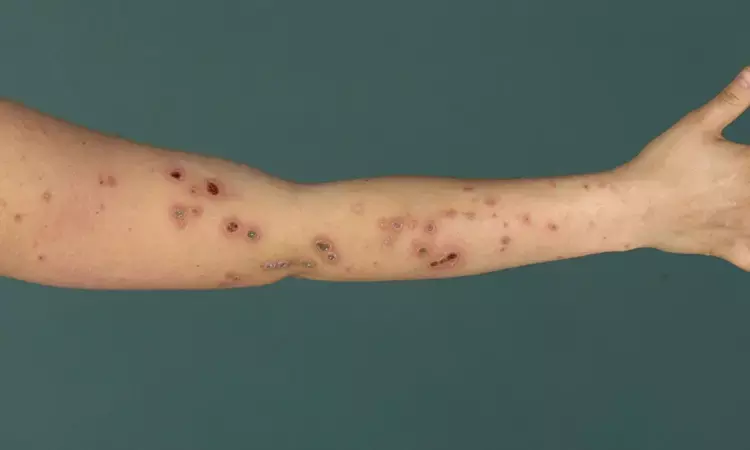- Home
- Medical news & Guidelines
- Anesthesiology
- Cardiology and CTVS
- Critical Care
- Dentistry
- Dermatology
- Diabetes and Endocrinology
- ENT
- Gastroenterology
- Medicine
- Nephrology
- Neurology
- Obstretics-Gynaecology
- Oncology
- Ophthalmology
- Orthopaedics
- Pediatrics-Neonatology
- Psychiatry
- Pulmonology
- Radiology
- Surgery
- Urology
- Laboratory Medicine
- Diet
- Nursing
- Paramedical
- Physiotherapy
- Health news
- Fact Check
- Bone Health Fact Check
- Brain Health Fact Check
- Cancer Related Fact Check
- Child Care Fact Check
- Dental and oral health fact check
- Diabetes and metabolic health fact check
- Diet and Nutrition Fact Check
- Eye and ENT Care Fact Check
- Fitness fact check
- Gut health fact check
- Heart health fact check
- Kidney health fact check
- Medical education fact check
- Men's health fact check
- Respiratory fact check
- Skin and hair care fact check
- Vaccine and Immunization fact check
- Women's health fact check
- AYUSH
- State News
- Andaman and Nicobar Islands
- Andhra Pradesh
- Arunachal Pradesh
- Assam
- Bihar
- Chandigarh
- Chattisgarh
- Dadra and Nagar Haveli
- Daman and Diu
- Delhi
- Goa
- Gujarat
- Haryana
- Himachal Pradesh
- Jammu & Kashmir
- Jharkhand
- Karnataka
- Kerala
- Ladakh
- Lakshadweep
- Madhya Pradesh
- Maharashtra
- Manipur
- Meghalaya
- Mizoram
- Nagaland
- Odisha
- Puducherry
- Punjab
- Rajasthan
- Sikkim
- Tamil Nadu
- Telangana
- Tripura
- Uttar Pradesh
- Uttrakhand
- West Bengal
- Medical Education
- Industry
50% of CAPS patients present with cutaneous involvements, including distal inflammatory edema: JAMA

A new study found that in patients with Catastrophic antiphospholipid syndrome (CAPS), nearly half of them presented with cutaneous involvement having a wide spectrum of clinical presentations like distal inflammatory edema. The study results were published in the journal JAMA Dermatology.
Antiphospholipid syndrome (APS) presents with a rare, severe complication called Catastrophic antiphospholipid syndrome (CAPS) characterized by diffuse small-vessel thromboses leading to multiorgan failure. Despite several clinical presentations, cutaneous involvement has not been thoroughly described. Hence researchers conducted a study to describe the cutaneous involvement, its clinical and pathological features, and outcomes in these patients and to compare them without cutaneous involvement.
A retrospective cohort study was conducted by including patients from the French multicenter APS/systemic lupus erythematosus register (ClinicalTrials.gov: NCT02782039) by December 2020. All patients meeting the revised international classification criteria for CAPS were included, and patients with cutaneous manifestations were analyzed more specifically. Patients with CAPS having cutaneous involvement, clinical and pathological data, as well as course and outcome, were gathered from patients and compared to those in the register who did not have cutaneous involvement.
Results:
- Among 120 patients with at least 1 CAPS episode, there were 65 (54%) with skin involvement with a median [range] age, of 31 [12-69] years).
- Among the total 43 [66%] were women.
- Among 21 of 60 (35%) patients with available data, Catastrophic antiphospholipid syndrome was the first APS manifestation.
- The main lesions were recent-onset or newly worsened livedo racemosa (n = 29, 45%), necrotic and/or ulcerated lesions (n = 27, 42%), subungual splinter hemorrhages (n = 19, 29%), apparent distal inflammatory edema (reddened and warm hands, feet, or face) (n = 15, 23%), and/or vascular purpura (n = 9, 14%).
- Microthrombi of dermal capillaries were seen in 15 out of 16 biopsies performed during CAPS episodes (94%).
- In more than 90% (58 of 64) of patients, these lesions healed without sequelae.
- Patients with cutaneous involvement showed a trend toward more frequent histologically proven CAPS (37% vs 24%, P = .16) than those without such involvement, while mortality did not differ significantly between the groups (respectively, 5% vs 9%, P = .47).
Thus, the present study reported a wide variety of skin involvement during CAPS and their healing without major sequelae in most patients.
Further reading: Dupré A, Morel N, Yelnik C, et al. Cutaneous Involvement in Catastrophic Antiphospholipid Syndrome in a Multicenter Cohort of 65 Patients. JAMA Dermatol. Published online December 07, 2022. doi: 10.1001/jamadermatol.2022.5221
BDS, MDS
Dr.Niharika Harsha B (BDS,MDS) completed her BDS from Govt Dental College, Hyderabad and MDS from Dr.NTR University of health sciences(Now Kaloji Rao University). She has 4 years of private dental practice and worked for 2 years as Consultant Oral Radiologist at a Dental Imaging Centre in Hyderabad. She worked as Research Assistant and scientific writer in the development of Oral Anti cancer screening device with her seniors. She has a deep intriguing wish in writing highly engaging, captivating and informative medical content for a wider audience. She can be contacted at editorial@medicaldialogues.in.
Dr Kamal Kant Kohli-MBBS, DTCD- a chest specialist with more than 30 years of practice and a flair for writing clinical articles, Dr Kamal Kant Kohli joined Medical Dialogues as a Chief Editor of Medical News. Besides writing articles, as an editor, he proofreads and verifies all the medical content published on Medical Dialogues including those coming from journals, studies,medical conferences,guidelines etc. Email: drkohli@medicaldialogues.in. Contact no. 011-43720751




